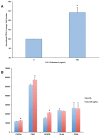LDL cholesterol modulates human CD34+ HSPCs through effects on proliferation and the IL-17 G-CSF axis
- PMID: 23991206
- PMCID: PMC3753239
- DOI: 10.1371/journal.pone.0073861
LDL cholesterol modulates human CD34+ HSPCs through effects on proliferation and the IL-17 G-CSF axis
Abstract
Background: Hypercholesterolemia plays a critical role in atherosclerosis. CD34+ CD45dim Lineage- hematopoietic stem/progenitor cells (HSPCs) give rise to the inflammatory cells linked to atherosclerosis. In mice, high cholesterol levels mobilize HSPCs into the bloodstream, and promote their differentiation to granulocytes and monocytes. The objective of our study was to determine how cholesterol levels affect HSPC quantity in humans.
Methods: We performed a blinded, randomized hypothesis generating study in human subjects (n=12) treated sequentially with statins of differing potencies to vary lipid levels. CD34+ HSPC levels in blood were measured by flow cytometry. Hematopoietic colony forming assays confirmed the CD34+ population studied as HSPCs with multlineage differentiation potential. Mobilizing cytokine levels were measured by ELISA.
Results: The quantity of HSPCs was 0.15 ± 0.1% of buffy coat leukocytes. We found a weak, positive correlation between CD34+ HSPCs and both total and LDL cholesterol levels (r(2)=0.096, p < 0.025). Additionally, we tested whether cholesterol modulates CD34+ HSPCs through direct effects or on the levels of mobilizing cytokines. LDL cholesterol increased cell surface expression of CXCR4, G-CSFR affecting HSPC migration, and CD47 mediating protection from phagocytosis by immune cells. LDL cholesterol also increased proliferation of CD34+ HSPCs (28 ± 5.7%, n=6, p < 0.03). Finally, the HSPC mobilizing cytokine G-CSF (r(2)=0.0683, p < 0.05), and its upstream regulator IL-17 (r(2)=0.0891, p < 0.05) both correlated positively with LDL cholesterol, while SDF-1 levels were not significantly affected.
Conclusions: Our findings support a model where LDL cholesterol levels positively correlate with CD34+ HSPC levels in humans through effects on the levels of G-CSF via IL-17 promoting mobilization of HSPCs, and by direct effects of LDL cholesterol on HSPC proliferation. The findings are provocative of further study to determine if HSPCs, like cholesterol levels, are linked to CVD events.
Conflict of interest statement
Figures







References
-
- Swirski FK, Nahrendorf M (2013) Leukocyte behavior in atherosclerosis, myocardial infarction, and heart failure. Science 339: 161-166. doi:10.1126/science.1230719. PubMed: 23307733. - DOI - PMC - PubMed
-
- Minder CM, Blaha MJ, Horne A, Michos ED, Kaul S et al. (2012) Evidence-based use of statins for primary prevention of cardiovascular disease. Am J Med 125: 440-446. doi:10.1016/j.amjmed.2011.11.013. PubMed: 22387091. - DOI - PubMed
-
- Soehnlein O, Swirski FK (2013) Hypercholesterolemia links hematopoiesis with atherosclerosis. Trends Endocrinol Metab 24: 129-136. doi:10.1016/j.tem.2012.10.008. PubMed: 23228326. - DOI - PMC - PubMed
-
- Massberg S, Schaerli P, Knezevic-Maramica I, Köllnberger M, Tubo N et al. (2007) Immunosurveilence by hematopoietic progenitor cells through blood, lymph and peripheral tissues. Cell 131: 994-1008. doi:10.1016/j.cell.2007.09.047. PubMed: 18045540. - DOI - PMC - PubMed
-
- Massa M, Rosti V, Ferrario M, Campanelli R, Ramajoli I et al. (2005) Increased circulating hematopoietic and endothelial progenitor cells in the early phase of acute myocardial infarction. Blood 105: 199-206. doi:10.1182/blood-2004-05-1831. PubMed: 15345590. - DOI - PubMed
Publication types
MeSH terms
Substances
LinkOut - more resources
Full Text Sources
Other Literature Sources
Medical
Research Materials

